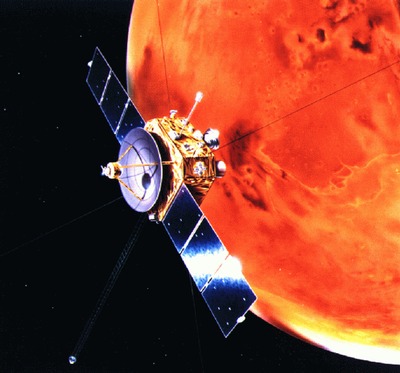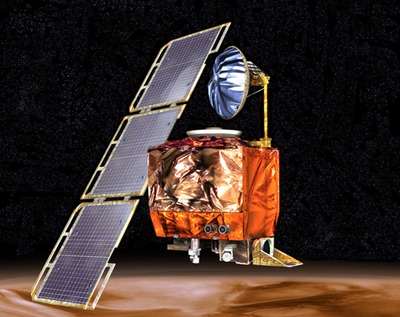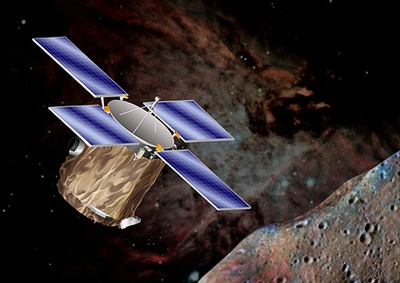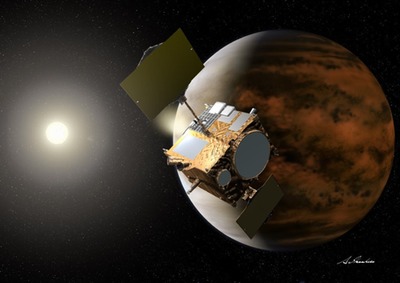Planetary orbit insertion failures (part 1)by Andrew J. LePage
|
| Only time will tell if Akatsuki comes out of its current hibernation and can salvage something its original mission. |
Akatsuki’s engine ignited on schedule and flew behind Venus as planned, resulting in an expected loss of signal. Unfortunately, when it reemerged from behind Venus and communications were reestablished, the probe was found to be in a safe mode. Because of the slow communication rate through the spacecraft’s low gain antenna, it was not until the following day that controllers confirmed the cause of the safe mode and confirmed that Akatsuki had failed to enter orbit around Venus. A subsequent investigation showed that Akatsuki’s main engine had only fired for about three minutes before shutting down. It is believed that deposits formed in a valve between the helium pressurization and the hydrazine fuel tanks, decreasing the fuel flow to the main engine in the process. The high temperatures resulting from the combustion of the oxidizer-rich mixture damaged the engine, forcing an early shutdown.
After test firings of the main engine on September 7 and 14, 2011, showed that it was too damaged to be used again, engineers developed a backup plan to use the spacecraft’s smaller monopropellant thrusters (which share the hydrazine supply of the main engine) to enter orbit when the spacecraft once again reaches the vicinity of Venus in November 2015, a close approach made possible by a series of course corrections performed in November 2011. Unfortunately, because of the lower efficiency of its monopropellant thrusters and the fuel used to alter its course, Akatsuki will only be able to enter an orbit with a periapsis of 5,000 kilometers (3,100 miles) and an apoapsis of between 300,000 and 400,000 kilometers (190,000 and 250,000 miles), compromising its science mission as a result. Another major issue is that this five-year delay in reaching Venus exceeds the original 4.5-year design life of the spacecraft, which is likely to be further reduced by the higher-than-expected temperatures Akatsuki has experienced as a result of its unplanned stay in a 203-day solar orbit largely inside that of Venus. Only time will tell if Akatsuki comes out of its current hibernation and can salvage something its original mission.
 Artist concept of Nozomi in orbit around Mars. (credit: NASA) |
Nozomi
If the current problems for Japan’s planetary aspirations with Akatsuki were not bad enough, they followed the heartbreaking failure of Nozomi. Nozomi (also known as Planet-B) was launched on July 4, 1998, with the intent of entering orbit around Mars on October 11, 1999, to study the Martian atmosphere and, with a periapsis as low as 150 kilometers (93 miles), further investigate the magnetic patterns originally observed in the Martian crust by Mars Global Surveyor. Instead of being sent directly into a transfer orbit to Mars, engineers devised a complicated series of maneuvers in the Earth-Moon system over five and a half months that included a pair of lunar flybys to boost the payload sent to Mars.
The M-V launch vehicle successfully placed Nozomi into an extended 703 by 489,382-kilometer (437 by 304,153-mile) orbit around the Earth. Nozomi then completed a pair of lunar flybys on September 24 and December 18, 1998. The plan was to make one last pass 1,003 kilometers (623 miles) above the Pacific Ocean on December 20, coupled with a seven-minute burn of its bipropellant main engine, to finally send the probe on its way to Mars. A malfunctioning valve resulted in more fuel being used than planned, and Nozomi gained insufficient velocity to reach Mars. To compound the problem, a pair of course correction burns the following day also used more propellant than planned and left Nozomi with insufficient propellant to complete its intended mission.
| Probably one of the most infamous orbit insertion failures involved the loss of the Mars Climate Orbiter, whose mode of failure could only happen in America. |
Engineers developed an alternative plan to salvage the mission. Nozomi would stay in solar orbit for an extra four years and make a pair of flybys of the Earth in December 2002 and June 2003 to permit the probe to approach Mars at a significantly slower velocity in December 2003, allowing it to enter orbit with its remaining propellant. Unfortunately, the backup plan began to unravel on April 21, 2002, when powerful solar flares damaged Nozomi’s communications and power systems. While technicians devised workarounds to maintain contact with the craft, an electrical short in the system used to control the temperature of its hydrazine propellant meant that its vital fuel supply would freeze solid when the temperature fell below 2°C (35°F), as would happen when the spacecraft travelled beyond Earth’s orbit.
While the hydrazine thawed out in time for the first Earth flyby at a distance of 29,510 kilometers (18,341 miles) on December 21, 2002, and the second flyby of 11,023 kilometers (6,851 miles) on June 19, 2003, it froze solid on its way to Mars, preventing the propulsion system from working. These problems were compounded when all contact with Nozomi was lost on July 8, 2003, and never regained as a result of the damaged communication system. Nozomi silently flew an estimated 894 kilometers (556 miles) above the surface of Mars on December 10, 2003, and continued on into a two-year solar orbit.
 Artist concept of the Mars Climate Orbiter in orbit around Mars. (credit: NASA) |
Mars Climate Orbiter
Probably one of the most infamous orbit insertion failures involved the loss of the Mars Climate Orbiter (MCO), whose mode of failure could only happen in America with its stubborn refusal to go metric like the rest of the world. MCO was one of NASA’s ’90s-era missions touted as being “faster, better, cheaper.” Unfortunately, one of the ways to make the mission cheaper was to cut back on testing and oversight of the contractors. MCO carried a pair of instruments to study the atmosphere of Mars from a circular 421-kilometer (262-mile) orbit including one that was originally carried by the ill-fated Mars Observer spacecraft lost in 1993 in another orbit insertion failure. Initially, MCO would enter an elliptical orbit around Mars with a nominal periapsis of 210 kilometers and a period of about 15 hours. After entering orbit, MCO would use an aerobraking technique first employed by one of its predecessors, the Mars Global Surveyor launched in 1996, to gradually lower its orbit over the course of the next couple of months. One final propulsive maneuver would then raise its periapsis out of the Martian upper atmosphere and circularize its orbit for science operations.
MCO was successfully launched on December 11, 1998, and performed its first course correction ten days later. A second minor course correction took place on March 4, 1999. But by the time of the third course correction on July 25 just 60 days before arrival at Mars, the mission’s navigation team was beginning to suspect that something was wrong with the design and execution on the course correction maneuvers since their calculations consistently showed MCO tracking closer to Mars than their predictions. On September 19, a fourth course correction took place, but tracking showed that MCO would pass 173 kilometers from Mars instead of the nominal 210 kilometers. Since MCO could come as close as 85 kilometers of Mars and survive, controllers elected not to performa a fifth course correction.
But with only hours to go before orbit insertion on September 23, 1999, JPL navigators were reporting that MCO would pass only 110 kilometers from Mars. This would be survivable but MCO would need to raise its periapsis altitude during its first orbit. The full magnitude of the navigation error did not become apparent until it was too late. About five minutes into its 16-minute, 23-second orbit insertion burn, contact with MCO was lost as it passed behind Mars 39 seconds earlier than predicted. MCO was never heard from again. Apparently the navigation error had continued to grow and MCO passed as close as 57 kilometers above the Martian surface, where it was destroyed.
| Unlike most orbit insertion failures, NEAR was fortunate enough to recover and salvage its mission. |
An investigation into the loss of MCO later revealed that the error was embarrassingly trivial. In order to predict accurately the path of MCO, JPL navigators needed to take into account all of the forces acting on the spacecraft, including the small impulses of its attitude control thrusters. Instead of being supplied with a table of thruster impulses in the metric units of newton-seconds that the JPL navigation programs required, the spacecraft contractor, Lockheed Martin, had supplied a table in units of pound-seconds. As a result, the navigational corrections for the attitude thruster firings were too small by a factor of 4.5. This error, combined with a greater number of thruster firings than originally planned because of the asymmetric arrangement of solar panels and other addendages, caused the fatal navigation error. The loss of MCO and NASA’s Mars Polar Lander two months later from unrelated causes resulted in a major review of mission engineering practices for such smaller missions and a two-year delay of further missions to Mars.
 Artist concept of NEAR-Shoemaker above 433 Eros. (credit: NASA) |
NEAR
The American NEAR (Near Earth Asteroid Rendezvous) mission, which was the first of NASA’s Discovery class of small planetary science missions to be launched, experienced a propulsion system failure that nearly scuttled its mission to orbit the near Earth asteroid 433 Eros for one year. NEAR launched on February 19, 1996, and was later renamed NEAR Shoemaker after the late American planetary scientist Eugene Shoemaker (1928–1997). On June 27, 1997, NEAR flew 1,212 kilometers (753 miles) from 253 Mathilde, gathering vital new data on asteroids in the process. On July 3, NEAR performed a two-part deep space maneuver using its primary 450-newton (100-pound-force) engine to set it on course for a 540-kilometer (336-mile) flyby of the Earth on January 23, 1998, and subsequently on course to rendezvous with Eros on January 10, 1999.
The rendezvous with Eros planned to use a series of four propulsive maneuvers over the course of three weeks. The first and largest one, on December 20, 1998, required the main engine to burn for 15 minutes to change NEAR’s velocity by 650 meters per second (1,450 miles per hour) roughly matching the spacecraft’s orbit with that of Eros in the process. Three subsequent maneuvers would adjust the spacecraft’s approach trajectory and finally establish an orbit around the low-gravity target. However, NEAR’s main engine shut down a fraction of a second into its burn and communications with NEAR were lost as the spacecraft began to tumble. After controllers finally reestablished communications 27 hours later, they found that its thrusters had fired thousands of times as the spacecraft tried to regain control of its attitude, expending 29 kilograms (64 pounds) of propellant in the process and reducing its propellant margins to zero. Investigators never definitively determined the cause of the problem, but software and operational errors apparently only made the problem worse.
Ground controllers immediately put a new plan into effect to salvage the mission. It was already too late to rendezvous with Eros this time around, so scientists had to content themselves for the moment with a quick reconnaissance as NEAR flew by Eros at a distance of 3,927 kilometers (2,441 miles) on December 23. Under the new plan, NEAR performed the major burn of its main engine on January 3, 1999, to roughly match the orbit of Eros. After another 13 months in solar orbit, NEAR finally completed its rendezvous with one final small maneuver on February 14, 2000. NEAR was able to successfully execute its one-year mission at Eros ending it with a successful touchdown on the asteroid’s surface (a mission-ending task for which NEAR was not originally designed) on February 12, 2001, where it remained until it was shut down 16 days later. Unlike most orbit insertion failures, NEAR was fortunate enough to recover and salvage its mission.
